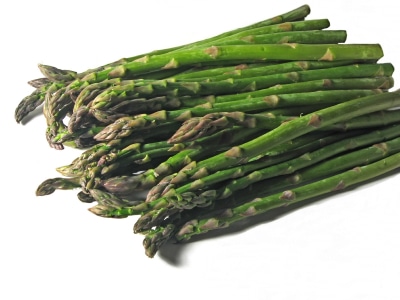
Spring Vegetables: Spinach
Long considered a vegetable superstar, spinach contains over a dozen different flavonoid compounds that help fight inflammation and inhibit the formation of cancer cells. Spinach is loaded with immune-boosting beta carotene and bone-healthy vitamin K. It contains the antioxidant, lutein, which protects against eye disease, and peptides that help lower blood pressure.
Buying and Preparing: Spinach is at its peak between from March through May. Select deep green leaves with no evidence of wilting. Only wash spinach when ready to use, since overly moist leaves will encourage spoiling.
*For a quick fix, heat a tablespoon of olive oil and sauté spinach with minced garlic or chopped scallions for approximately 2 minutes. Finish with a sprinkle of lemon juice, sea salt, and pepper.
Spring Vegetables: Asparagus
Asparagus is an excellent source of vitamins A and C which help us resist infection and aid in the healing process. An average serving contains a significant amount of heart-healthy folate and, inulin, a nutrient that protects the colon by promoting the growth of healthy bacteria in the intestinal tract.
Buying and Preparing: In most parts of the U.S., asparagus is at its best from April through June. Look for stalks that are firm, smooth and rounded. The tips should be closed and purple in color. Though the thickness of the stem will not impact the flavor, it is important to choose stems that are similar in size to ensure uniform cooking.
*For a quick fix, preheat the oven to 400 degrees F. Toss asparagus spears with sesame oil, salt, and pepper. Spread in a single layer on a baking sheet and roast for 20 minutes or until crisp-tender.
Spring Vegetables: Peas
Though prized as a versatile side dish, peas are often undervalued for their wonderful health benefits. They contain the phytonutrient, coumestrol, which protects against stomach cancer and alpha-linolenic acid (ALA), a valuable source of heart-healthy omega-3 fat. Due to their substantial amount of protein and fiber, peas are extremely effective in regulating carbohydrate digestion and maintaining proper blood sugar levels, which may be particularly beneficial for people living with Type 2 Diabetes.
Buying and Preparing: The peak season for fresh, shelling peas is April through June. Look for pods that are plump, medium green and void of spots or yellow discoloration. Mature pods should contain peas that are large and packed close together.
*For a quick fix, shell and steam fresh peas for 1 to 2 minutes. Gently combine the cooked peas with sautéed shallots, fresh basil, bottled Alfredo sauce, and cubed, cooked chicken breast. Serve over pasta.
Spring Vegetables: Beets
To remain disease free, the body must be efficient in eliminating toxins. Beets are especially rich in antioxidants called betalains, which neutralize harmful substances and stimulate the detoxification process. Recent studies also point to a promising array of powerful molecules in beet fiber that may reduce the risk of colon, lung, breast and prostate cancers.
Buying and Preparing: The most tender, flavorful beets are available from May through October. Choose beets that are deep in color and free of spots or bruising. When stored in sealed plastic bags, beets will keep for approximately 3 weeks in the refrigerator.
*For a quick fix, steam beets for 15 minutes (more will diminish the concentration of betalains). When beets have cooled, slice thinly and combine with red onion rings, chopped, fresh parsley and a splash of balsamic vinaigrette.
Sources:
Healthy Immunity, Lorna R. Vanderhaeghe, Macmillan Canada, 2001
Natural Healing Foods, Karen Davis, Global Communication Group, 2000
whfoods.com
Related Articles By Cathe:
6 Ways Eating Vegetables Lowers the Risk of Cardiovascular Disease
If You Upgrade Your Lifestyle Later in Life, Do You Still Get Health Benefits?
6 Healthy Autumn Produce Choices to Pick Up at Your Local Farmer’s Market
Plant Sterols: Do These Natural Compounds in Plants Have Health Benefits?
6 Lesser Known Vegetables with Powerful Health Benefits
Canned, Fresh, and Frozen Vegetables: Are They Equally Nutritious?
5 Ways to Add Breakfast Vegetables to Your Diet.
Are Raw Vegetables Better for You?
4 Science-Backed Reasons to Add More Fermented Vegetables to Your Diet
Does Peeling Fruits and Vegetables Eliminate Most of the Pesticides?

